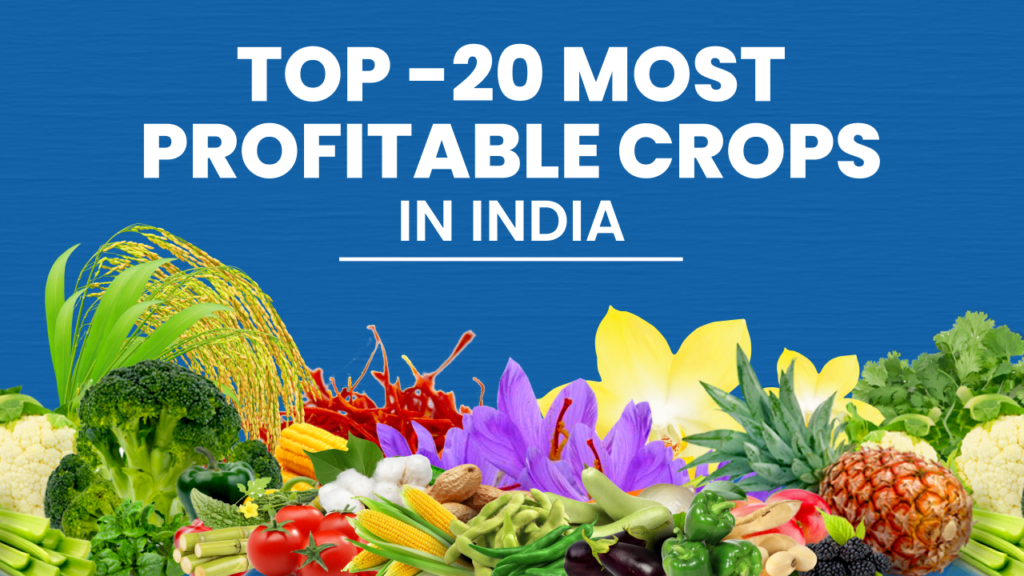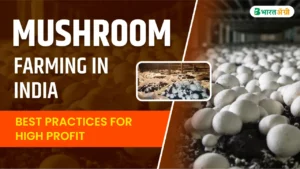
India, known for its diverse agro-climatic zones, is home to a wide variety of crops that sustain its economy and population. Agriculture plays a vital role in the country’s livelihood, and with advancements in farming techniques and market dynamics, certain crops have emerged as particularly profitable. In this blog, we will explore the most profitable farming crops in India, shedding light on their importance, growing regions, seasons, and potential earnings. These crops offer high returns and contribute significantly to the agricultural sector, making them a valuable choice for farmers and agribusinesses.
Top Most Profitable Crops in India
Below are the most profitable farming crops in India.
Wheat
Wheat is one of the most cultivated crops in India, especially in states like Punjab, Haryana, and Uttar Pradesh. It is a staple food, making it a high-demand crop year-round. The Rabi season is ideal for wheat, requiring a cool climate and well-drained soil. With proper management, wheat yields can reach up to 30 quintals per acre, providing an average income of ₹30,000 to ₹40,000 per acre per year.
Rice
Rice is the most cultivated crop in India, and it is grown extensively in West Bengal, Uttar Pradesh, and Andhra Pradesh. It thrives in warm, humid climates with ample water supply, typically during the Kharif season. Yielding up to 35 quintals per acre, rice can generate an average income of ₹35,000 to ₹50,000 per acre annually, making it a high value crop.
Sugarcane
Sugarcane is a most lucrative crop, particularly in Maharashtra, Uttar Pradesh, and Karnataka. It grows best in tropical climates with rich, loamy soil and ample water. With a growing season that spans 10-16 months, sugarcane can produce up to 80 tons per acre, providing a significant income of ₹1,00,000 to ₹1,50,000 per acre per year.
Cotton
Cotton, a key cash crop, is widely cultivated in Gujarat, Maharashtra, and Andhra Pradesh. It requires a warm climate and well-drained sandy loam soil, primarily growing during the Kharif season. Cotton yields about 8-10 quintals per acre, offering an average income of ₹20,000 to ₹40,000 per acre annually.
Saffron
Saffron is one of the most profitable farming crops in India, predominantly grown in Jammu & Kashmir. It needs a temperate climate with well-drained soil, and the growing season is from June to November. Despite low yields of 5-6 kg per acre, saffron can generate a substantial income of ₹1,50,000 to ₹2,00,000 per acre per year.
Tea
Tea is a significant cash crop in Assam, West Bengal, and Tamil Nadu. It thrives in tropical and subtropical climates with well-distributed rainfall. With continuous plucking throughout the year, tea can yield up to 2,500 kg per acre, offering an average income of ₹1,00,000 to ₹1,50,000 per acre annually.
Spices (Turmeric, Ginger)
Spices like turmeric and ginger are high value crops in India which is grown in Kerala, Andhra Pradesh, and Tamil Nadu. They require a warm, humid climate with well-drained soil. With yields of 20-25 quintals per acre, spices can generate an income of ₹1,00,000 to ₹1,50,000 per acre per year.
Potato
Potato is a profitable crop in states like Uttar Pradesh, West Bengal, and Bihar. It grows best in cool, temperate climates during the Rabi season. With a yield of up to 80 quintals per acre, potatoes can provide an average income of ₹40,000 to ₹50,000 per acre annually.
Tomato
Tomato is a lucrative crop, especially in Maharashtra, Karnataka, and Andhra Pradesh. It requires a warm climate and fertile soil, with a growing season throughout the year. Tomato yields can reach up to 30 tons per acre, offering an income of ₹1,00,000 to ₹1,50,000 per acre annually.
Onion
Onion is another profitable crop grown in Maharashtra, Gujarat, and Karnataka. It needs a cool, dry climate and well-drained soil, typically during the Rabi and Kharif seasons. With yields of up to 25 tons per acre, onions can generate an income of ₹50,000 to ₹70,000 per acre annually.
Banana
Banana is a highly profitable crop in Tamil Nadu, Maharashtra, and Kerala. It thrives in tropical climates with rich, loamy soil. With a growing season of about 12 months, banana yields can reach up to 50 tons per acre, providing an income of ₹2,00,000 to ₹3,00,000 per acre annually.
Pomegranate
Pomegranate is a high value crop grown in Maharashtra, Gujarat, and Karnataka. It requires a hot, dry climate and well-drained soil. With a yield of up to 8 tons per acre, pomegranates can generate an income of ₹2,00,000 to ₹3,00,000 per acre per year.
Papaya
Papaya is a profitable fruit crop in Tamil Nadu, Maharashtra, and Andhra Pradesh. It grows well in tropical and subtropical climates with well-drained soil. With a yield of up to 40 tons per acre, papayas can provide an income of ₹1,00,000 to ₹1,50,000 per acre annually.
Soybean
Soybean is the most lucrative crop in Madhya Pradesh, Maharashtra, and Rajasthan. It thrives in warm climates with well-drained soil, typically during the Kharif season. With yields of up to 20 quintals per acre, soybeans can generate an income of ₹40,000 to ₹50,000 per acre annually.
Groundnut
Groundnut is a valuable crop in Gujarat, Andhra Pradesh, and Tamil Nadu. It requires a warm climate and sandy loam soil, primarily growing during the Kharif season. Groundnut yields can reach up to 25 quintals per acre, offering an income of ₹50,000 to ₹60,000 per acre annually.
Sunflower
Sunflower is a profitable oilseed crop in Karnataka, Maharashtra, and Andhra Pradesh. It grows best in warm climates with well-drained soil. With yields of up to 15 quintals per acre, sunflowers can generate an income of ₹30,000 to ₹40,000 per acre annually.
Maize
Maize is a versatile crop grown in Uttar Pradesh, Karnataka, and Bihar. It thrives in warm climates with well-drained soil, typically during the Kharif and Rabi seasons. Maize yields can reach up to 30 quintals per acre, offering an income of ₹30,000 to ₹40,000 per acre annually.
Grapes
Grapes are a high value fruit crop in Maharashtra, Karnataka, and Tamil Nadu. They require a warm, dry climate and well-drained soil. With a yield of up to 10 tons per acre, grapes can provide an income of ₹2,00,000 to ₹3,00,000 per acre annually.
Mango
Mango is a profitable fruit crop in Uttar Pradesh, Andhra Pradesh, and Maharashtra. It grows best in tropical and subtropical climates with well-drained soil. With a yield of up to 10 tons per acre, mangoes can generate an income of ₹1,00,000 to ₹2,00,000 per acre annually.
Chili
Chili is a lucrative spice crop in Andhra Pradesh, Maharashtra, and Karnataka. It requires a warm, humid climate and well-drained soil. With yields of up to 20 quintals per acre, chilies can provide an income of ₹50,000 to ₹70,000 per acre annually.
Note: The mentioned yield can increase depending on climate, crop protection, and cultivation practices. Income also depends on the market situation.
Conclusion
- The most profitable farming crops in India demonstrate the potential for high returns and sustainable agricultural practices.
- From staple crops like wheat and rice to high-value crops such as saffron and pomegranate, these farming ideas cater to diverse markets and climatic conditions.
- By choosing the right crops and implementing efficient farming techniques, Indian farmers can achieve significant economic gains.
- These profitable farming practices contribute to the country’s food security.
- Profitable farming ideas also support rural development in India.
FAQs
Which is the most cultivated crop in India?
Rice is the most cultivated crop in India, covering extensive areas and providing a staple food source for the population.
Saffron, pomegranate, and grapes are among the most lucrative crops, offering high returns due to their market demand and value.
Farmers can increase profitability by adopting advanced farming techniques, using high-quality seeds, efficient water management, and exploring value-added products.
The average income per acre varies widely, with crops like wheat and rice generating ₹30,000 to ₹50,000, while high value crops like saffron can earn up to ₹2,00,000 per acre annually.
Organic farming is considered profitable due to the growing demand for chemical-free, health-conscious products, fetching higher market prices and promoting



